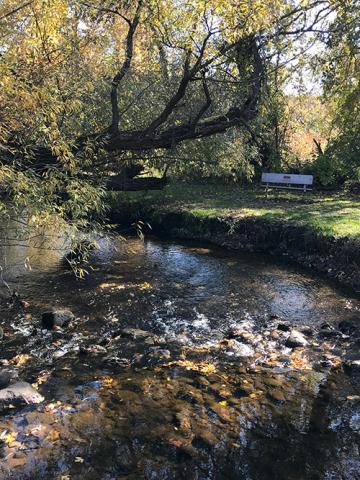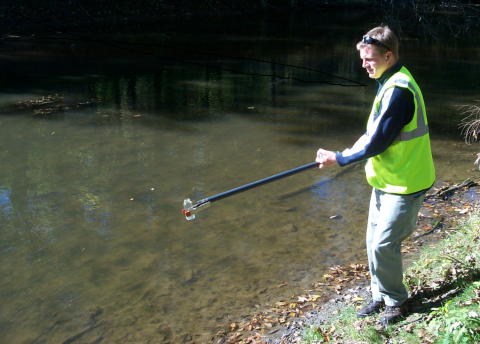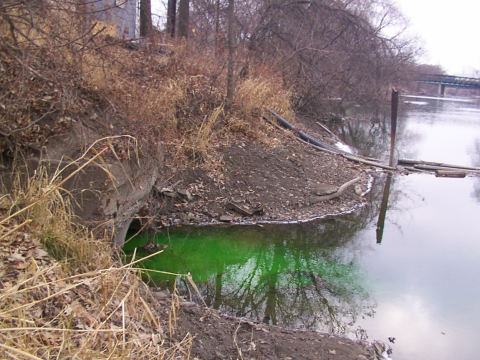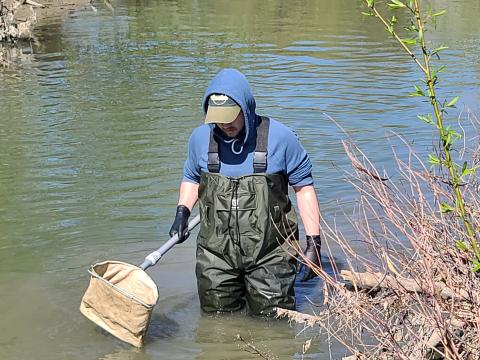Local water resources: Lake St. Clair and the Clinton River watersheds

- Lake St. Clair is a significant natural resource that affects the region geographically, economically and recreationally. Lake St. Clair is also a source of drinking water for a large number of people in southeast Michigan.
- The Clinton River Watershed encompasses the majority of Macomb County, most of Oakland County and small portions of Lapeer and St. Clair counties. It drains approximately 760 square miles, an area which is populated by an estimated one and one-half million people.
These water resources offer a number of recreational opportunities to both Macomb County residents and visitors. These opportunities include boating, swimming, kayaking, canoeing, fishing, or simply relaxing alone the shores.
Commitment
Macomb County is committed to protecting and improving water quality throughout our watersheds, including the Clinton River and Lake St. Clair. The health department has various programs to achieve this goal. These programs include the Surface Water Improvement and Monitoring (SWIM) team, beach monitoring, Illicit Discharge and Elimination Program, and the Property Transfer regulation.
What we do to help protect the water and you

Surface Water Monitoring
The Surface Water Improvement and Monitoring (SWIM) team, formed after a recommendation of the Blue Ribbon Commission Report, was created in the latter part of 1997 with funds committed by the Macomb County Board of Commissioners. One component of its mission is the monitoring of surface water quality throughout the county. This mission is accomplished by systematic sampling of county watersheds.
The surface water monitoring effort has grown to over 50 sites where samples are collected at least monthly during the recreational season and tested for Escherichia coli (E. coli) bacteria. The data collected is entered into a database. Information is reviewed for trends that might indicate problems requiring further investigation. If problems are found, the health department seeks corrective efforts to eliminate the pollution source.
Surface water quality is monitored for compliance with the Total Body Contact Standard Regulatory compliance is based on a geometric mean of three or more samples within a defined sampling area.
The surface water testing data should NOT be used to determine if an area is suitable for swimming. Water depth, bottom slope, current, availability of safety equipment, and availability of lifeguards are additional important factors in the determination of a safe swimming location.

Illicit Discharge Elimination Program (IDEP)

The Illicit Discharge Elimination Program (IDEP) was created through grant funding as an extension of the already successful Surface Water Improvement and Monitoring (SWIM) Team Program. IDEP is charged with the duties of searching out and inspecting illicit discharges in Macomb County. This is accomplished by surveying the open drains, streams, rivers and shorelines in the county and looking for illicit discharges. Suspicious discharges are sampled and investigated. If a problem is found, the county works diligently with the owner of the discharge to correct the problem.
70 million gallons per year
Estimated amount of wastewater prevented from discharging into Macomb County surface waters and Lake St. Clair:
This has been accomplished by the Illicit Discharge Elimination Program:
- Surveying over 745 miles of open drains, including rivers and streams. During these surveys, more than 5130 outfalls were identified and tested.
- Investigating 7134 residential, commercial, industrial and institutional facilities since 1998.
- From these investigations, 1236 or 17% were found to have an illicit discharge. Illicit discharges include failing septic fields or a direct discharge to a river, stream, roadside ditch, ground surface or storm drain. These discharges have either been corrected or are in the correction process.
E. coli is a bacteria naturally found in the intestinal tracts of humans and other animals. The presence of E. coli in the water indicates possible contamination with human or animal waste. This means other pathogens might be in the water. E. coli is also easy to test for in the environment which makes it a great indicator organism. It is used to set water quality standards for recreational waters.
There are two types of body contact for recreational waters. They are for full body contact and partial body contact. Full body contact means you are fully submerged in the water and could unintentionally ingest the water. Swimming is considered full body contact. Partial body contact means only part of your body is submerged and you are unlikely to ingest the water. Activities in this category include wading, fishing, and boating.
Michigan has set two water quality standards for full body contact: a single day geomean and a 30-day geomean. The single day geomean is 300 E. coli colonies per 100 ml. The 30-day geomean is 130 E. coli colonies per 100 ml over a 30 day period with at least five sampling events.
Michigan also has set the standard for partial body contact at a daily maximum of 1000E. coli colonies per 100 ml
There are many activities that can cause diminished water quality. These can include sewage discharges, failing septic systems, improper animal waste disposal, and dumping waste down the storm drain or in the ditch. If you see an activity that is polluting our waters, you can contact the Macomb County Health Department or the Macomb County Public Works Office for further investigation.
Pollution problems residents might observe include:
- A failing septic system
- Sewage discharging from a sewer cleanout
- A pollutant discharging from a pipe to a ditch, stream, river or lake
- Someone pouring something down a storm drain or in their front ditch.
- An odor coming from a storm drain
- Discoloration of a stream or lake
If you see a problem that could be polluting our waters, you can report it. You can submit a complaint or observation by calling us at 586-469-5236 or email us the information. A detailed description of the observation, including location, time, and what was observed. Pictures are also helpful.
If it is after business hours or on a weekend, you can call the Pollution Hotline at 877-679-4337.
If your complaint or observation does not fall under our jurisdiction, we will forward it to the appropriate department.
Lake St. Clair is an important water resource that is used for drinking, recreation and commercial activities. Often our everyday activities can unintentionally contribute to water quality degradation. The following are simple things we all can do to help improve water quality in our lakes, rivers, and streams.
- Conserve the amount of water you use. Extra water overwhelms sewage treatment plants, especially during heavy rains, and contributes to combined sewer overflows. Excessive water usage can also cause premature failure of septic systems.
- Make sure that all of the sewage and waste water from your home or business is directed to a sanitary sewer system or an approved and properly functioning onsite septic system.
- Properly operate and maintain your septic system. Discharges from malfunctioning systems can impact beach water quality. Septic system maintenance information is available from the Macomb County Health Department.
- Disconnect your gutter downspouts from underground drains and divert the discharge away from your house.
- Discharge boat or recreational vehicle waste only at approved disposal locations.
- Properly dispose of household chemicals, automotive fluid waste and other household hazardous waste. Do Not dispose of these types of materials in storm drain catch basins or on the ground surface. Use non-toxic alternatives when possible. Contact the Macomb County Health Department for collection information.
- When washing cars, direct wash water away from streets and storm drains. Try washing your car on the lawn.
- Repair vehicles in areas where leaks and spills can not flow to a storm drain, but can be contained and cleaned up properly.
- Practice proper lawn care. Keep fertilizer, pesticide and herbicide use to a minimum and follow all label directions.
- Routinely clean up pet waste and properly dispose of it in the garbage
Retention basin and combined/sanitary sewer overflows
Sanitary Sewer Overflows (SSOs): are discharges of raw sewage from municipal sanitary sewer systems. SSOs can release untreated sewage into basements or out of manholes and onto city streets, playgrounds and into streams before it can reach a treatment facility. SSOs are often caused by blockages in sewer lines and breaks in the sewer lines. Older sanitary sewer systems can also be prone to groundwater infiltration due to cracks in the older pipes, footing drains and downspout connections, and undersized systems. When a rain event occurs, this storm water can enter the sanitary sewer pipes and overwhelm the system, resulting in an overflow. SSOs are typically not treated.
Combined Sewer Overflows (CSOs): are discharges of a mixture of storm water and sanitary waste water when the flow capacity of a sewer system is exceeded during rainstorms and/or rapid snow melt. A combined sewer system is when there is one set of pipes for both sanitary sewage and storm water. During large rain events and/or rapid snow melt, this extra water overwhelms the system. CSOs can be treated or untreated.
Retention Treatment Basin Overflows (RTBs): are discharges of combined sanitary sewage and storm water. These retention treatment basins are typically able to able to capture this mixture and provide adequate treatment, including disinfection.
For more information on overflows, including historical data, you can visit Michigan Department of Environment, Great Lakes, and Energy.
Health and safety recommendations for persons playing or working in Lake St. Clair, the Clinton River and its tributaries

Recommendations
Lake St. Clair and the Clinton River system can be fun to play in and enjoy for all residents and visitors in Macomb County. The following recommendations are intended to reduce your exposure to contaminants and the subsequent potential for injury or disease while engaging in activities and projects to clean debris from the Lake St. Clair shoreline and its tributaries or when recreating in this vast fresh water system.
• You should have no open wounds or cuts.
• Immunizations should be current; especially Tetanus (within 10 years).
• A first-aid kit should be available.
• Wear gloves and protective clothing to prevent cuts and abrasions. (Arms and legs
are vulnerable areas).
• Use sunscreen and wear proper apparel to protect against sunburn or sunstroke.
• Wear safety boots or shoes with sturdy soles to prevent punctures. Try to keep the
lower extremities dry.
• If full body immersion occurs, go to a site to wash yourself thoroughly and put on
dry clothing. Be sure to thoroughly cleanse the face, hands and hair.
• Splashing of individuals should not be tolerated.
• Work at a moderate pace, especially in hot weather and direct sunlight. Do not
overexert yourself.
• Take frequent breaks as fatigue can precipitate accidents.
• Get assistance with heavy objects. Avoid slippery areas. Exercise extra care when
handling sharp objects.
• Avoid getting water around your mouth, nose, ears and eyes. If your eyes are
exposed to lake or river water, rinse them with clean, clear water.
• Apply insect repellent to exposed areas of the body.
• If a wound occurs, stop working! If it does NOT need emergency medical attention,
wash with soap and clean water and apply an antiseptic solution. Discontinue
working in the water or with material removed from the water if the wound cannot
be protected from contamination.
• Prior to eating or drinking, wash hands and face vigorously with soap and clean
water and dry with clean paper towels.
• Eating, drinking or smoking should be avoided during the clean-up activities.
• When work has finished for the day, place
• disposable apparel items in a plastic trash bag. Transport soiled clothing in a plastic
bag for laundering. Wash boots with dishwashing soap and a brush. Rinse with clean
water.
• Wash hands and face thoroughly and dry with clean towels.
• Go directly home!
• Wash all of your apparel in the hot cycle of the washing machine.
• Bathe or shower thoroughly using plenty of soap and water.
• If you experience any illness symptoms, contact your physician and mention that
you were working on lake or river clean-up activities.
• Please be advised that the risk of contracting disease is likely greater during the two or
three days immediately following major rainstorms.
Additional resources
Contact the Environmental Health Service Division
Mount Clemens: 586-469-5236 | Email: environmental.health@macombgov.org






